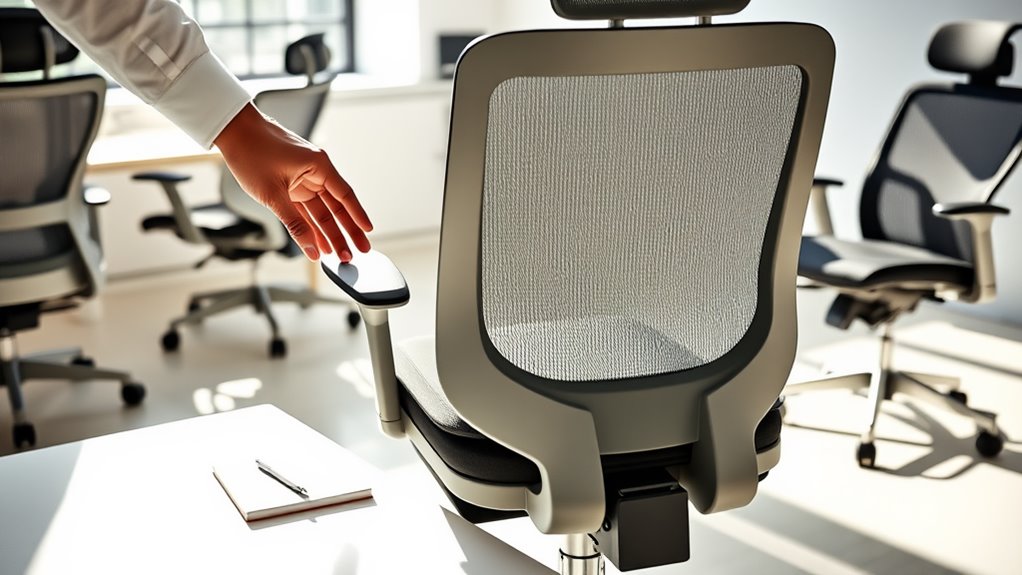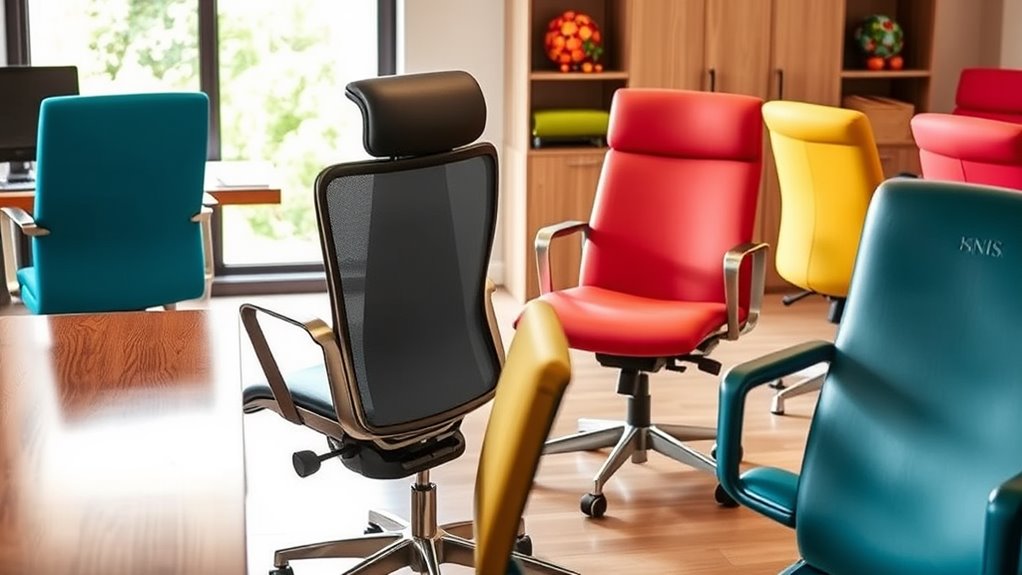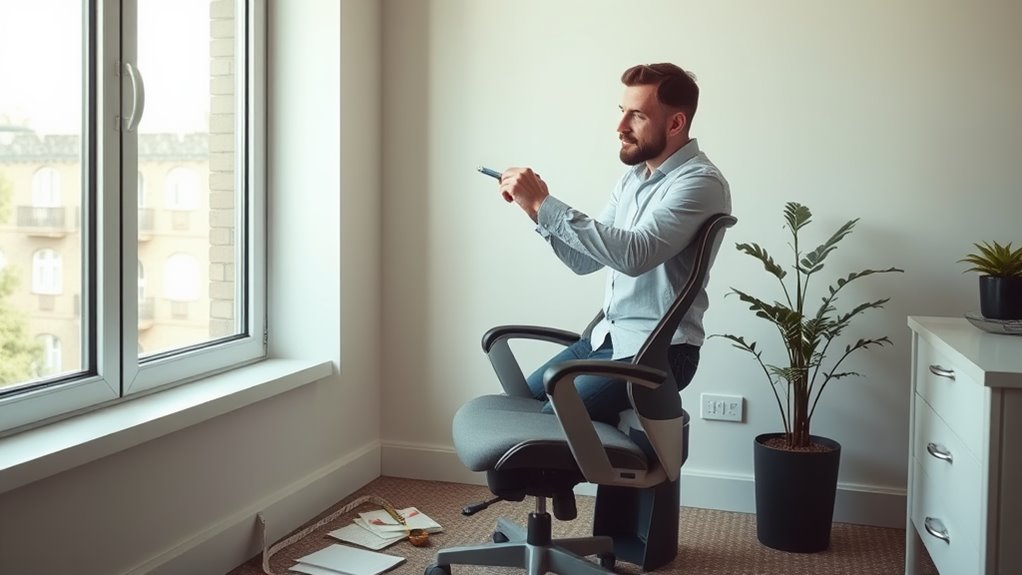To choose the perfect office chair without breaking the bank, focus on ergonomics for comfort and support. Set a realistic budget, targeting around 11% of your total office expenditure. Explore various types, like ergonomic and task chairs, and consider the durability of materials like mesh or leather. Test chairs for comfort and adjustable features whenever possible. Keep an eye on reviews and customer support options. There's plenty more to explore about maintaining your investment for long-term use.
Key Takeaways
- Set a realistic budget by allocating around 11% of total office expenditure for furniture, including extras for delivery and assembly.
- Prioritize ergonomic features such as adjustable lumbar support and right-angle armrests to enhance comfort and promote proper posture.
- Choose materials wisely; opt for durable options like mesh or leather that suit your comfort needs and maintenance preferences.
- Test chairs in showrooms by sitting for 15-20 minutes to evaluate comfort, support, and adjustability before making a purchase.
- Read customer reviews and research models to find high-rated chairs that fit your body type and budget without compromising on quality.
Understanding Ergonomics for Comfort and Support

When you sit at your desk for hours, understanding ergonomics becomes crucial for maintaining comfort and support.
Focus on the three key contact areas: your seat, work surface, and floor. It's important to choose a fully adjustable chair that supports proper posture, reducing strain and the risk of musculoskeletal disorders. Proper lumbar support is essential for individuals with existing back issues or long sitting hours, as it helps maintain the spine's natural curve.
Prioritize the three key contact areas—seat, work surface, and floor—for optimal ergonomic support and reduced strain.
Look for a chair that allows breathing room between the seat edge and your legs to avoid pressure on your knees. Adjustable seat height guarantees your feet rest flat on the floor, while lumbar support maintains your spine's natural curve.
Armrests should enable your elbows to form a right angle, allowing for easy movement. Prioritizing these ergonomic features enhances your comfort and productivity during long work sessions.
Setting a Budget That Works for You
Setting a budget for your office chair is essential to guarantee you find the right balance between cost and quality. Office chair prices can range from $50 to over $1,000, so it's vital to determine what you can spend.
A common practice is to allocate about 11% of your total office expenditure for furniture. For ergonomic chairs, expect to pay between $200 and $800, as these often offer better support and durability. Additionally, it's important to consider the size and layout of your office space when setting your budget to ensure the chair fits well within the environment.
Don't forget to factor in additional costs like delivery, assembly, and possible accessories, which can add 15% to your budget. Consider your office needs, employee count, and future growth to create a realistic budget that meets your requirements without overspending.
Exploring Different Types of Office Chairs

Selecting the right office chair can greatly enhance your work experience, as different types cater to various needs and preferences. Here's a quick overview of some popular office chair types to help you choose:
| Chair Type | Key Features |
|---|---|
| Task Chairs | Basic, productivity-focused, often wheeled |
| Ergonomic Chairs | Advanced support for posture and comfort |
| Executive Chairs | High-end, cushioned, for managerial roles |
| Drafting Chairs | Elevated for high desk tasks, versatile |
| Gaming Chairs | Stylish, ergonomic, adaptable for office use. Additionally, many chairs come with adjustable features to customize the fit for individual users. |
Evaluating Materials for Durability and Comfort
When picking an office chair, the materials play a vital role in your comfort and the chair's longevity. You'll want to weigh factors like breathability against durability, as well as how easy the chair is to maintain. Understanding these aspects can help you make a more informed decision that suits your needs. For instance, mesh office chairs excel in breathability, making them ideal for warmer environments or individuals prone to sweating.
Material Types Overview
Choosing the right material for your office chair greatly impacts both its durability and your comfort. Leather chairs are elegant and durable, softening over time for enhanced comfort. Fabric chairs offer versatility and a cozy feel, but they may require more maintenance. If you prefer a modern look, mesh chairs are breathable and maintain their shape well, while faux leather provides a budget-friendly alternative to genuine leather, though it may not last as long. Vinyl chairs resist stains and are easy to clean, but they lack breathability. Additionally, the choice of material significantly affects comfort, support, durability, and maintenance. Consider your needs and style preferences to find the perfect balance between durability and comfort in your office chair choice.
Breathability vs. Durability
The interplay between breathability and durability greatly influences your office chair experience.
If you work in a warm environment, mesh fabric is your best bet for breathability, though it may sag over time. Mesh upholstery offers excellent breathability and airflow, conforming to body shape for support, but may cause slight abrasions on clothing.
Leather offers unmatched durability and a luxurious feel but lacks airflow, making it uncomfortable in heat. Fabric chairs can be comfortable and affordable, but they tend to wear down quicker and trap moisture. Polyester strikes a balance with moderate durability and stain resistance, while woven fabrics can provide texture but mightn't breathe well.
Combining materials, like mesh with leather accents, can help you achieve both comfort and durability without breaking the bank. Choose wisely to enhance your seating experience!
Maintenance and Care Tips
Maintaining your office chair is essential for ensuring its durability and comfort over time.
Start by evaluating the materials; choose mesh, leather, or high-quality fabric for longevity. Regularly clean your chair with a damp cloth to prevent dirt buildup, and lubricate moving parts to minimize friction. Regular cleaning helps prevent wear and tear on the chair's components, ensuring smoother operation.
Check for loose screws and tighten them to maintain stability. Adjust tension settings according to your comfort needs, and be mindful not to exceed the chair's weight capacity.
Consider ergonomic designs with memory foam or breathable upholstery for added support.
Finally, look for chairs with long-term warranties, as they often reflect the manufacturer's confidence in their product's durability.
Following these tips will keep your chair comfortable and functional for years to come.
Assessing Key Features for Optimal Use
How can you guarantee your office chair meets your needs for comfort and support? Start by evaluating key features that enhance ergonomics and usability.
To ensure your office chair provides comfort and support, assess essential ergonomic features for optimal usability.
Look for adjustable components that fit your body type and promote proper posture. Focus on cushioning materials that offer breathability and comfort during long hours at your desk.
- Seat height adjustment to accommodate your individual needs.
- Backrest adjustability for tailored support and alignment.
- Lumbar support to maintain spinal health and reduce strain. A chair's ergonomics depend on your size, workstation arrangement, and tasks performed.
Tips for Testing Chairs Before Purchase

When testing chairs before you buy, focus on comfort and support first. Make certain the adjustability features can be tailored to your needs, so you stay comfortable throughout the day. Additionally, ensure that the chair you choose complies with minimal ergonomic requirements to promote proper alignment and support during extended use. Finally, check for durability to guarantee your investment lasts as long as you need it to.
Comfort and Support
Testing an office chair before purchase can make all the difference in your comfort and support during long workdays.
To guarantee you choose the right chair, follow these tips:
- Sit for at least 15-20 minutes: This helps you gauge how the chair feels over time, revealing any potential discomfort.
- Pay attention to pressure points: Notice if any areas of your body feel strained or uncomfortable, especially in the lower back or legs. An office chair with thoughtful lumbar support can significantly alleviate strain on your lower back.
- Assess back support: Verify the chair maintains the natural curve of your spine, even as you shift positions.
Adjustability Features
While comfort is essential, adjustability features play an equally important role in guaranteeing your office chair meets your specific needs. Here are some tips for testing chairs before you purchase:
| Adjustability Feature | What to Look For | Testing Tips |
|---|---|---|
| Seat Height Adjustment | Should allow feet to be flat on the floor | Adjust while sitting |
| Armrest Adjustability | Should support elbows at a 90-degree angle | Test positioning and comfort |
| Lumbar Support Adjustment | Must fit the spine's natural curve | Adjust and feel for support |
| Backrest Angle Adjustment | Should accommodate various positions | Test recline functionality |
| Seat Depth Adjustment | Should prevent pressure on the knees | Check comfort with back support |
Remember to visit a showroom and spend time in the chair to guarantee it fits your needs. An adjustable chair can greatly enhance back and neck health by supporting proper spinal alignment with its customizable features.
Test for Durability
After ensuring your office chair has the right adjustability features, it's important to assess its durability.
Look for chairs that comply with ISO 21015:2007 standards, as they undergo rigorous testing simulating both normal and misuse forces. You should also consider materials; mesh offers breathability, while leather provides a premium feel but requires upkeep. Additionally, chairs tested for office work chairs provide valuable insights into their expected performance under typical use conditions.
To test durability effectively, keep these tips in mind:
- Hands-On Testing: Sit in the chair during various activities to gauge comfort and sturdiness.
- Feedback Evaluation: Check user reviews to understand long-term durability from others' experiences.
- Warranty Check: A longer warranty often indicates a manufacturer's confidence in the chair's durability.
Online Shopping: Reviews and Customer Support
How can you guarantee you're making the right choice when shopping for an office chair online? Start by doing thorough research on ergonomic features like adjustable lumbar support and seat height.
Read reviews critically; patterns in feedback can reveal a chair's strengths or weaknesses. Look for models with high ratings, such as the Branch Verve or Herman Miller Aeron, and pay attention to reviews from users with similar body types. Additionally, consider that over 50 chairs tested can provide a reliable benchmark for comfort and ergonomics.
Don't forget to assess customer support options. Check warranty coverage, return policies, and how responsive the manufacturer is to customer concerns.
Finally, set a budget while balancing necessary features for comfort and durability, ensuring you find a chair that fits both your needs and your wallet.
Maintenance and Care for Your Office Chair
To keep your office chair in top condition, it's vital to establish a regular maintenance routine. Regular inspections and cleaning can extend your chair's lifespan and maintain its functionality. Here are some essential tips:
- Use a vacuum cleaner with an upholstery attachment to remove dust and debris. Routine maintenance through regular vacuuming and wiping down helps keep the chair looking fresh.
- Inspect and tighten loose screws and bolts to guarantee stability.
- Apply a silicone-based lubricant to moving parts like wheels.
For cleaning, use a damp cloth with mild soap and avoid soaking the fabric.
For leather chairs, dust regularly and apply conditioner annually.
Keep your workspace clutter-free to prevent damage to casters.
Frequently Asked Questions
How Do I Know if a Chair Fits My Body Type?
To know if a chair fits your body type, adjust the seat height, check the width and depth, and guarantee lumbar support aligns with your back. Test it out for comfort and mobility.
What Is the Average Lifespan of an Office Chair?
The average lifespan of an office chair is about 7-10 years, depending on quality and usage. Regular maintenance and proper care can greatly extend its life, so keep an eye on wear and tear.
Can a Chair Improve My Productivity at Work?
Yes, a chair can considerably improve your productivity at work. By enhancing comfort and promoting good posture, it reduces fatigue and distractions, allowing you to focus better and work more efficiently throughout the day.
Are There Specific Brands Known for Budget-Friendly Ergonomic Chairs?
Yes, you'll find brands like SMUG, DFLIVE, and Colamy Kirin offer budget-friendly ergonomic chairs. They combine comfort, support, and affordability, making them great options for creating a productive workspace without overspending.
How Often Should I Replace My Office Chair?
You should replace your office chair every 5-10 years, depending on usage and condition. Look for signs like worn cushions or discomfort. A timely replacement can enhance your comfort, productivity, and overall well-being.
